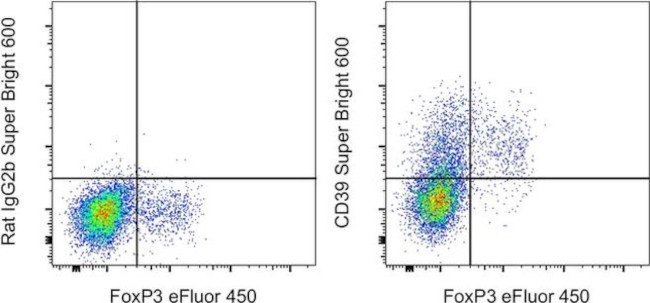Search Thermo Fisher Scientific
Invitrogen
CD39 Monoclonal Antibody (24DMS1), Super Bright™ 600, eBioscience™
FIGURE: 1 / 1
CD39 Antibody (63-0391-82) in Flow

Product Details
63-0391-82
Species Reactivity
Host/Isotype
Recommended Isotype Control
Class
Type
Clone
Conjugate
Excitation/Emission Max
Form
Concentration
Purification
Storage buffer
Contains
Storage conditions
Shipping conditions
RRID
Product Specific Information
Description: The 24DMS1 monoclonal antibody reacts with mouse CD39, also known as NTPDaseI. E-NTPDases are enzymes that convert nucleoside tri- and diphosphates (NTDPs) into nucleoside monophosphate (NMP), thereby removing toxic extracellular ATP and ADP. CD39 is the dominant member of this family in the immune system and is involved in suppression of inflammation and control of platelet activation. CD39 can impact expression of CD73, another E-NTPase. Together, these molecules influence inflammation responses. CD39 is expressed on B cells, Langerhans cells and most monocytes. In addition, CD39 is found on a subset of CD4+ T cells that are mostly CD25+FoxP3+ T reg cells. T reg cells from CD39-null mice showed impaired suppressive properties in vitro and in vivo.
Applications Reported: This 24DMS1 antibody has been reported for use in flow cytometric analysis.
Applications Tested: This 24DMS1 antibody has been tested by flow cytometric analysis of mouse splenocytes. This may be used at less than or equal to 1.0 µg per test. A test is defined as the amount (µg) of antibody that will stain a cell sample in a final volume of 100 µL. Cell number should be determined empirically but can range from 10^5 to 10^8 cells/test. It is recommended that the antibody be carefully titrated for optimal performance in the assay of interest.
Super Bright 600 is a tandem dye that can be excited with the violet laser line (405 nm) and emits at 600 nm. We recommend using a 610/20 bandpass filter. Please make sure that your instrument is capable of detecting this fluorochrome.
When using two or more Super Bright dye-conjugated antibodies in a staining panel, it is recommended to use Super Bright Complete Staining Buffer (Product # SB-4401) to minimize any non-specific polymer interactions. Please refer to the datasheet for Super Bright Staining Buffer for more information.
Light sensitivity: This tandem dye is sensitive to photo-induced oxidation. Please protect this vial and stained samples from light.
Fixation: Samples can be stored in IC Fixation Buffer (Product # 00-8222) (100 µL of cell sample + 100 µL of IC Fixation Buffer) or 1-step Fix/Lyse Solution (Product # 00-5333) for up to 3 days in the dark at 4°C with minimal impact on brightness and FRET efficiency/compensation. Some generalizations regarding fluorophore performance after fixation can be made, but clone specific performance should be determined empirically.
Excitation: 405 nm; Emission: 600 nm; Laser: Violet Laser
Super Bright Polymer Dyes are sold under license from Becton, Dickinson and Company.
Target Information
CD39 cell surface antigen is a 70-100kD molecule expressed on peripheral blood B cells, monocytes, T cell clones, and also weakly expressed on granulocytes. CD39 has intrinsic ecto-ATPase activity. Expression of CD39 is induced on T cells and increased on B cells as a late activation antigen.
For Research Use Only. Not for use in diagnostic procedures. Not for resale without express authorization.
How to use the Panel Builder
Watch the video to learn how to use the Invitrogen Flow Cytometry Panel Builder to build your next flow cytometry panel in 5 easy steps.
References (0)
Bioinformatics
Protein Aliases: ATP diphosphohydrolase; ATP-DPH; CD39; DKFZp686D194; DKFZp686I093; Ecto-apyrase; Ecto-ATP diphosphohydrolase 1; Ecto-ATPDase 1; Ectonucleoside triphosphate diphosphohydrolase 1; FLJ40921; FLJ40959; Lymphoid cell activation antigen; NTPDase 1; NTPDase1; Nucleoside triphosphate diphosphohydrolase 1
Gene Aliases: 2610206B08Rik; AA408691; Cd39; Entpd1; NTPDase-1
UniProt ID: (Mouse) P55772
Entrez Gene ID: (Mouse) 12495

Performance Guarantee
If an Invitrogen™ antibody doesn't perform as described on our website or datasheet,we'll replace the product at no cost to you, or provide you with a credit for a future purchase.*
Learn more
We're here to help
Get expert recommendations for common problems or connect directly with an on staff expert for technical assistance related to applications, equipment and general product use.
Contact tech support

